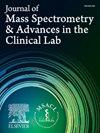高分辨率质谱测量n端氨基甲酰化血红蛋白作为慢性疾病血尿素水平升高的潜在标志物
IF 3.4
4区 医学
Q2 MEDICAL LABORATORY TECHNOLOGY
Journal of Mass Spectrometry and Advances in the Clinical Lab
Pub Date : 2025-01-01
DOI:10.1016/j.jmsacl.2025.01.001
引用次数: 0
摘要
n端氨甲酰化血红蛋白(CarHb)反映长期血液尿素水平,有可能作为慢性肾脏疾病(CKD)和其他血液尿素水平升高的慢性疾病的标志物。建立了一种液相色谱-高分辨率质谱(LC-HR-MS)测定CarHb的方法。方法根据血红蛋白α和β亚基氨基化肽与天然n端肽的峰面积比计算表观CarHb/Hb比值。对健康人、慢性阻塞性肺疾病患者和慢性阻塞性肺疾病(COPD)患者的血液样本进行了分析。结果CKD和COPD患者的表观CarHb/Hb比值明显高于健康人。然而,在CKD和COPD患者组之间没有观察到显著差异。结论本研究建立了一种LC-HR-MS方法,用于定量表观CarHb/Hb比值,并探索其在临床诊断中的应用潜力。CarHb是监测肾脏疾病和其他血液尿素水平升高的慢性疾病的有希望的标志物。除CarHb外,还可以探索其他氨甲酰化蛋白作为临床诊断和预后标志物的使用。本文章由计算机程序翻译,如有差异,请以英文原文为准。
High-resolution mass spectrometry measurement of N-terminal carbamylated hemoglobin as a potential marker for chronic diseases with elevated blood urea levels
Introduction
N-terminal carbamylated hemoglobin (CarHb) reflects long-term blood urea levels and has potential as a marker for chronic kidney disease (CKD) and other chronic conditions with elevated blood urea levels. A liquid chromatography-high-resolution mass spectrometry (LC-HR-MS) method was developed to measure CarHb.
Methods
Apparent CarHb/Hb ratios were calculated from the peak area ratios of carbamylated to native N-terminal peptides digested from hemoglobin alpha and beta subunits. Blood samples from healthy individuals, CKD patients, and chronic obstructive pulmonary disease (COPD) patients were analyzed.
Results
The apparent CarHb/Hb ratios were significantly higher in CKD and COPD patients compared to healthy individuals. However, no significant differences were observed between the CKD and COPD patient groups.
Conclusions
In this study, an LC-HR-MS method was developed for quantifying the apparent CarHb/Hb ratios and exploring their potential for clinical diagnostic applications. CarHb is a promising marker for monitoring kidney diseases and other chronic conditions with elevated blood urea levels. Beyond CarHb, the use of other carbamylated proteins as clinical diagnostic and prognostic markers can be explored.
求助全文
通过发布文献求助,成功后即可免费获取论文全文。
去求助
来源期刊

Journal of Mass Spectrometry and Advances in the Clinical Lab
Health Professions-Medical Laboratory Technology
CiteScore
4.30
自引率
18.20%
发文量
41
审稿时长
81 days
 求助内容:
求助内容: 应助结果提醒方式:
应助结果提醒方式:


